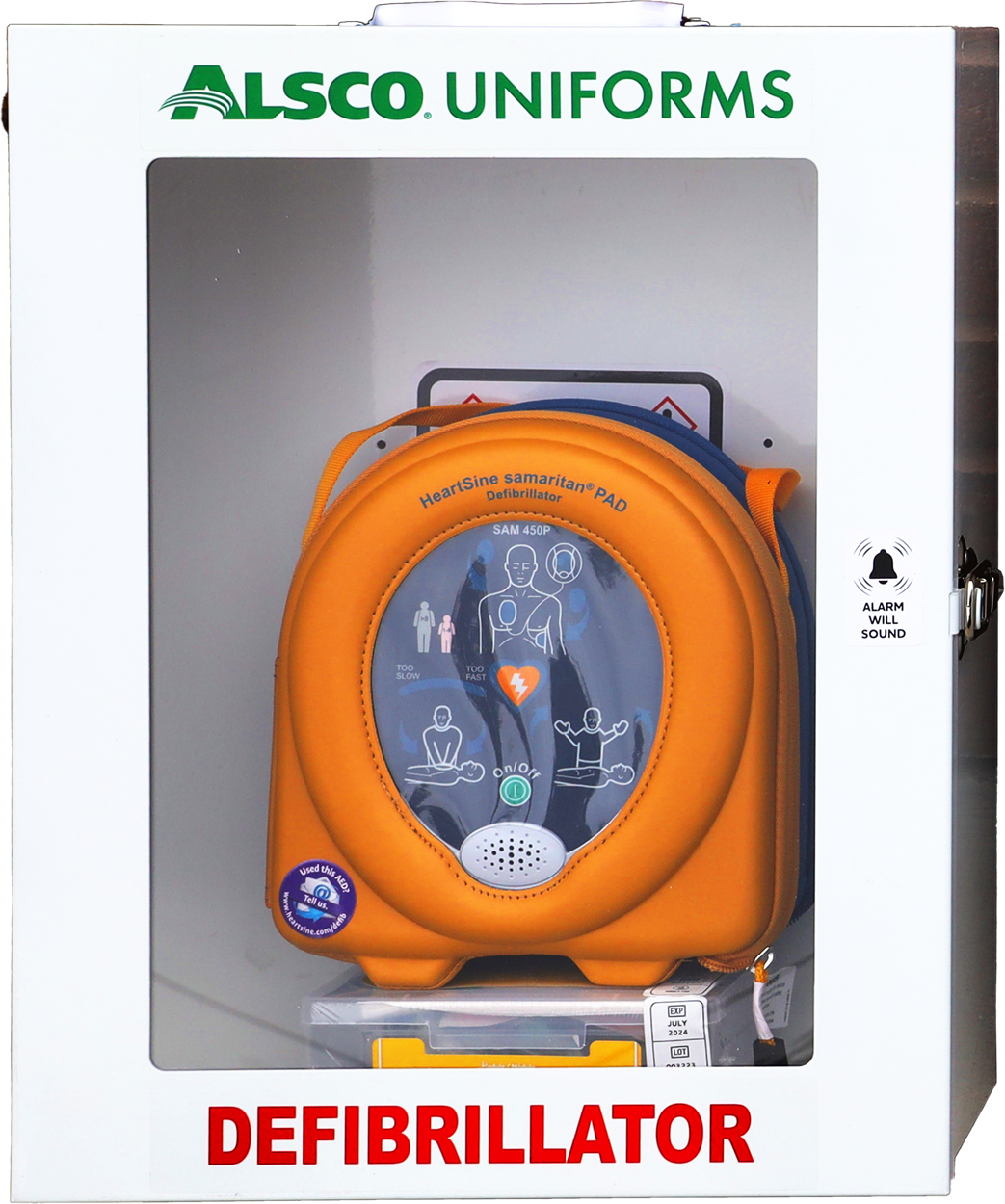
An automated external defibrillator (AED) is a wall-mounted machine that doesn’t take up a lot of space but can have a big impact. Understanding how to get an AED could be the first step you take toward saving a life in your business.
What Is an AED?
An AED is used to help people experiencing cardiac arrest. During these episodes, the heart beats irregularly (or not at all), allowing blood to pool. An AED sends an electric shock directly into the heart muscle in an attempt to restore normal rhythm.
The National Institutes of Health says more than 18,000 Americans have a cardiac event that could be treated with an AED. An estimated 1,700 lives are saved every year by bystanders using AEDs. Having one in a business can mean the difference between life and death for an employee or customer.
In a study of AEDs in New York State schools, researchers found that AEDs were used in 59 of 71 cardiac events, and of those who were treated, 40 survived. Studies like this make it clear why you need an AED machine.
The U.S. Food and Drug Administration (FDA) explains that AEDs work in the following manner:
The user turns on the device and hears instructions about how to use it.
The user places two electrodes (sticky pads with sensors) on the victim’s chest.
The electrodes send data to the machine, and it determines whether a shock is needed and how strong it should be.
If the shock is needed, the machine tells the user to push a button to deliver it. Some machines will deliver the shock without a button push, and it will tell the user to stand back.
How to Get the Right AED
The following steps will help you understand how to get the right AED. Notice that each step is relatively simple, and completing all of them could mean saving a life. Here’s what to do.
Step 1: Analyze Your Space
A person experiencing a cardiac event needs a shock within three to five minutes. Use this time frame to determine how many devices you might need. Additionally, identify the parts of your space that contain a dense cluster of people. You may need AEDs in places like elevators, reception areas, lobbies, and cafeterias. You could also put them close to your first aid kits.
Step 2: Get a Prescription
The FDA supervises the manufacture and sale of AEDs. In most cases, the FDA requires buyers to provide a physician’s prescription before the AED purchase. A doctor can ensure you’re placing the device in the right position, coordinate with the authorities, and ensure people are trained.
Step 3: Choose a Device
The FDA doesn’t recommend one device over another, but it does keep a list of machines that have been through the approval process. It’s smart to consult this published list before you buy something for your organization.
Step 4: Install the AED
When your machines arrive, install them in the locations you identified in the planning process. Each device should contain detailed instructions about how to mount them. If you have any questions, contact the manufacturer for clarification before you move forward.
Step 5: Contact Your Local EMS
Your community’s emergency medical services (EMS) needs to know about AES availability. In most states, you’re required to tell the EMS that you have a device. And if you use the EMS, you have to report that too.
The doctor who helped you with the AED prescription may help you complete this step. If not, you must handle it yourself.
Step 6: Train Your Staff
AEDs are designed for bystanders with no medical training, and they are very easy to use. However, your staff should be trained on your machine and know how to perform CPR as well. Make sure all staff members know exactly where the closest AED is located. They need to act quickly in an emergency.
Training programs can help staffers understand what a cardiac problem looks like and when an AED might be appropriate. Training can also ensure that your staff doesn’t use the machine when it’s not safe to do so.
Step 7: Understand Your Maintenance Requirements
While installing a machine is important, taking care of it is critical too. The instruction manual that came with your device should outline how to perform routine maintenance and tell you how often to do so. Ensure that maintenance tasks are appropriately assigned and that the work is documented when it’s complete.
Is It Safe to Install an AED?
Once you’ve learned how to get an AED, the worries may begin. For example, you may be concerned about lawsuits if the device is (or isn’t) used on the premises. Know that you can put these worries to rest.
All 50 states and the District of Columbia include AEDs in their Good Samaritan laws. That means you can’t be held responsible if someone used the device in an attempt to help someone else. The owner of the device also can’t be held responsible.
It’s safe for you to install an AED in your facility. Doing so could help you to save a life.
Alsco Uniforms Health & Safety
Employees who work in safe environments are more productive. Health and safety services from Alsco Uniforms make that possible. We can ensure you have tested AEDs, first aid cabinets, floor mats, mops, PPE, and high-visibility clothing, all of which work together to keep your workplace safe.
Our health and safety services focus on cleaning, first aid supplies, floor safety, general safety, and PPE. Reach out to us today to learn more about how we can improve safety for you.
References
Bystanders Save Lives Using Defibrillator for Cardiac Arrest. (March 2018). National Institutes of Health.
Availability and Utilization of Automated External Defibrillators in New York State Schools. (September 2021). Frontiers in Pediatrics.
How AEDs in Public Places Can Restart Hearts. (November 2022). U.S. Food and Drug Administration.
Implementing an AED Program. (February 2012). American Heart Association.
AED Programs Q&A. (April 2018). American Heart Association.
Automated External Defibrillators (AEDs). (July 2023). U.S. Food and Drug Administration.
Automated External Defibrillators (AEDs). Occupational Safety and Health Administration, U.S. Department of Labor.
The AED in Resuscitation: It's Not Just about the Shock. (2011). Transactions of the American Clinical and Climatological Association.
